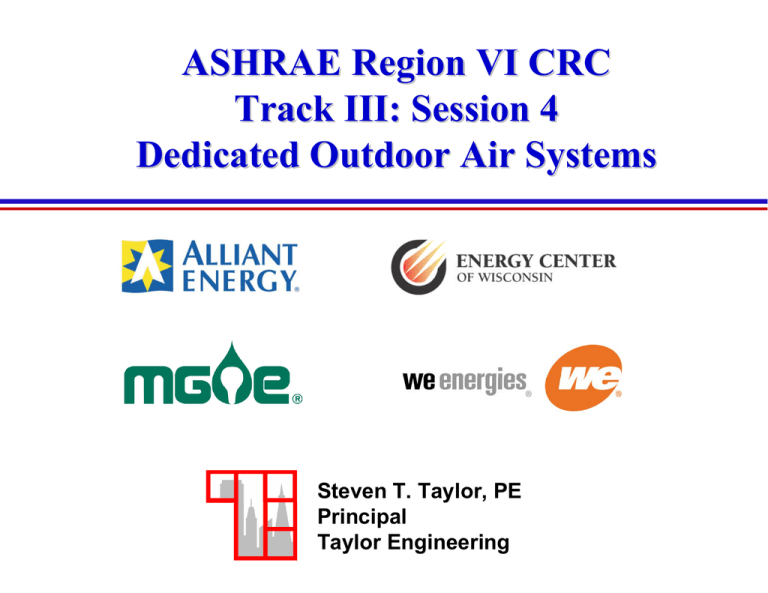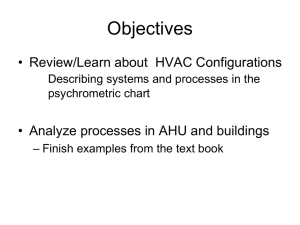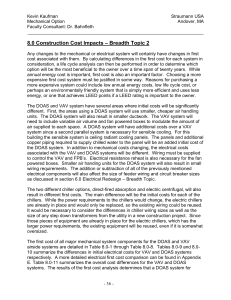Dedicated Outdoor Air Systems
advertisement

ASHRAE Region VI CRC Track III: Session 4 Dedicated Outdoor Air Systems Steven T. Taylor, PE Principal Taylor Engineering This program is registered with the AIA/CES for continuing professional education. As such, it does not include content that may be deemed or construed to be an approval or endorsement by the AIA of any material of construction or any method or manner of handling, using, distributing, or dealing in any material or product. Questions related to specific materials, methods, and services will be addressed at the conclusion of this presentation. Learning Objectives Recognize situations where dedicated outdoor air systems are advantageous Understand the characteristic strengths and weaknesses of each type of dedicated outdoor air system Outline the various dedicated outdoor air system control schemes and optimal applications Agenda Dedicated outdoor air systems Definitions True DOAS vs. Pre-conditioning systems Design options and examples Pre-conditioning systems DOAS Advantages and disadvantages Dedicated Outdoor Air Options All options are based 100% outdoor air handling unit with preconditioning capability Air cleaning/filtration Preheating Cooling Dehumidification Possible humidification Possible heat recovery Possible reheat Another system is provided for sensible cooling of space loads OA Dedicated Outdoor Air Options OAHU ducted to a central VAV system Inlet side of AHU (series) Outlet side of AHU (parallel) Pre-conditioning – other than pre-treatment, remainder of system is conventional OAHU ducted to each zone with zonal system for space sensible cooling/heating Inlet of zone terminal units Discharge of zone terminal units Dual duct VAV boxes served also by central VAV system Separate diffusers + fan-coils True DOAS Separate diffusers + radiant system separates ventilation & – dehumidification from space sensible loads Example Pre-Conditioning Series Arrangement Mechanical room serves as mixing plenum OA Constant Volume Box (or VAV if DCV is used) Return Air from Plenum Supply Air to VAV zones VSD Floor-by-Floor VAV AHU VSD Outdoor Air Handler Example Pre-Conditioning Parallel Arrangement Mechanical room serves as mixing plenum OA Constant Volume Box (or VAV if DCV is used) Return Air from Plenum Supply Air to VAV zones Outdoor air injected downstream VSD Floor-by-Floor VAV AHU VSD Outdoor Air Handler • Reduces size of f/f AHU – cost savings • Pre-occupancy and post-construction outdoor air purge can be done without the f/f AHU running • Added redundancy – some air can be supplied to floor without f/f AHU Underfloor System Precooling Option in lieu of return air bypass Locating downstream of main coil saves cost of OA Fan and reduces main coil size 63F Underfloor System Precooling 180 160 140 °F et w - lb u b t e, r u at r 70 pe m e 120 OA 80 60 50 60 RA SA 40 40 30 30 100 20 40 50 60 70 80 dry-bulb temperature, °F 90 100 110 humidity ratio, grains/lb of dry air 80 Underfloor System RA Bypass 180 160 80 140 °F et w - lb u b t e, r u at r 70 pe m e 120 OA 80 60 50 60 RA SA 40 40 30 30 100 20 40 50 60 70 80 dry-bulb temperature, °F 90 100 110 humidity ratio, grains/lb of dry air No difference in supply air temperature/humidity! VAV System Precooling 180 160 140 °F et w - lb u b t e, r u at r 70 pe m e 120 OA 80 60 50 60 RA SA 40 40 30 30 100 20 40 50 60 70 80 dry-bulb temperature, °F 90 100 110 humidity ratio, grains/lb of dry air 80 VAV System without pre-cooling 180 It is the humidity of the supply air that determines space humidity - the coil entering condition does not matter 50 160 80 140 °F et w - lb u b t e, r u at r 70 pe m e 120 OA 80 60 60 RA SA 40 40 30 30 100 20 40 50 60 70 80 dry-bulb temperature, °F 90 100 110 humidity ratio, grains/lb of dry air No difference in supply air temperature/humidity! Pre-Conditioning w/VAV Systems No advantages VAV inherently dehumidifies at standard supply air temperatures (e.g. 55F) Still need outdoor airflow measurement and control – mixed air plenum pressures vary Still need to deal with Standard 62.1 “multiple spaces” issues and inefficiencies Only may make sense: If used in parallel arrangement in f/f system if you can reduce costs of f//f AHUs In underfloor or displacement systems with warm supply air temperature in humid climates if less expensive than return air bypass DOAS Outdoor air ducted to zone, all latent cooling done by OAHU Common DOAS Claim: “Outdoor air rates are lower than central systems due to multiple spaces inefficiencies” ( RP PD D + RB AB ) ∑ Vot = EV Not always so: Occupant diversity largely offsets multiple spaces inefficiency Need ~15 to 30 cfm/p to handle latent load (depending on activity level and supply air temperature) – new Standard 62 rates are much lower for densely occupied spaces Rates tend to be higher for DOAS vs. VAV for densely occupied spaces and lower for spaces with relatively large “building component” rates such as offices Small School example OA Intake Flow Summary Ventilation System No population diversity credit Single-Zone Clg OA Intake Vot 8,900 Single-Zone Htg 11,100 No population diversity credit Penalty for “too warm” htg air 100% OA – CV 8,900 100% OA – VAV 7,040 VAV Default Ev 10,800 Conservatively low default Ev value VAV Calculated Ev 8,400 Series FP VAV 7,600 Equations for more accurate Ev Developed by Dennis Stanke, Trane Credit for population distribution Two ventilation paths, highest Ev DOAS in series with Fan-coils or Heat Pumps Outdoor Air Handler Fan-coil OA DOAS in parallel with Fan-coils or Heat Pumps Outdoor Air Handler OA Fan-coil Preferred to series arrangement: •Reduces size of fan-coil (airflow and tonnage) •Allows proper cfm/ton ratio for packaged terminal units •DOAS may run at night for pressurization in humid climates •DOAS may run alone for pre-occupancy and post-construction purge •Allows fan-coils to cycle on calls for heat/cool DOAS with dual duct boxes Cold air duct from VAV AHU Outdoor air duct from OAHU Dual Duct Box with Reheat DOAS with Separate Diffusers & Fan-coils or Heat Pumps Outdoor Air Handler Fan-coil OA DOAS with Flat Panel Radiant DOAS with Chilled Beams Active Chilled Beams (OA is supplied through beam to improve capacity through induction) Passive chilled beam (Radiation and convection only) Radiant advantages & disadvantages Advantages Quiet Little ceiling space required Possibly improved comfort No zonal fan energy No zonal filters/coils/fans Disadvantages Cost Low capacity – requires low space loads Ceiling aesthetics Chiller plant required Limited ceiling access Dewpoint control, condensation considerations May require increased outdoor air; or sub-cooling with reheat or runaround coil at OAHU if latent loads are high DOAS/Chilled Beam vs. Parallel Fan-powered VAV Milwaukee Office $0.350 $0.300 $0.250 Heat Fans $0.200 Pumps/Towers $/ft2/yr $0.150 Chillers $0.100 $0.050 $DOAS FPVAV DOAS Enhancements Supply OA cold without reheat Use heat recovery on OAHU per 90.1 And even in milder climates if OAHU runs 24/7 Make sure building is still pressurized – may eliminate this option in offices Use water-side economizer if cooling tower available Consider TES in areas with high demand charges Reduces capacity required of zonal systems Reduces first costs Reduces energy costs Exception: high latent load, low sensible load applications like theaters Also allows cold supply air temperature for radiant panel applications with high latent loads Reset OAHU supply air temperature based on zone feedback to minimize overcooling in mild weather Use CO2 sensors and VAV control of outdoor air for densely occupied spaces Use of pressure independent VAV boxes at zones also allows for off-hour isolation of areas and outdoor air setpoints can be changed without rebalancing Advantages of DOAS Assures design outdoor air rates delivered to space No complex outdoor airflow measurement/control devices No coil bypass or reheat No direct measurement of RH required No economizer and mixing plenum See slides from Session 2 Assures space maximum humidity levels are maintained No “multiple spaces” issues No concerns about minimum airflow setpoints and controls Outdoor air rates are usually NOT lower than VAV systems No dampers to freeze up, maintain No coil freeze problems from imperfect mixing No RH/enthalpy sensors to maintain Reduces fan energy if zonal system is passive (radiant, chilled beams) Reduces or eliminates reheat energy Less ceiling space required for duct mains Disadvantages Reduced annual outdoor air supply compared to systems with economizers Lack of economizer may cause energy usage to be higher than a well designed VAV system in mild climates High maintenance costs of zonal fan-coils or heat pumps Fisk study shows significant indoor air quality and associated health benefits from economizers Filters, coils, fans, pans, etc. Usually higher first costs depending on design details Need OA duct, CHW, and HW to each zone 4-pipe fan-coils and heat pumps are typically twice as expensive as VAV zones Savings in OAHU/duct sizes vs. VAV system AHU/duct sizes can offset the zone costs in some cases Questions? Steven Taylor Taylor Engineering 510.263.1540 staylor@taylor-engineering.com http://www.taylor-engineering.com



